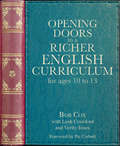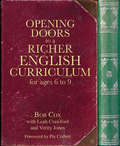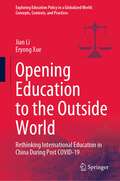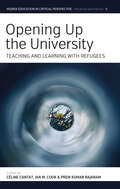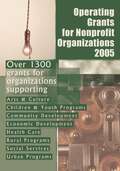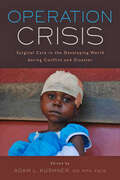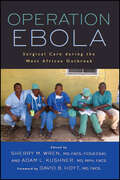- Table View
- List View
Opening The Classroom Door: Teacher, Researcher, Learner
by John Loughran Jeffrey NorthfieldThis account tracks the return to teaching of John Loughran, a teacher educator and educational researcher. After years of educating student teachers, he went back into the classroom for a year to practice what he himself had been teaching, but was often met with difficult pupil behaviour and unforeseen problems. Split into three sections, this book covers: * a teacher’s perspective on teaching* the students’ perspective on teaching and learning* learning from experience – the implications for teaching and learning. Using Loughran’s extensive teaching experience, this book describes how the classroom situations were played out and lessons to be learned.
Opening The Classroom Door: Teacher, Researcher, Learner
by John Loughran Jeffrey NorthfieldThis account tracks the return to teaching of John Loughran, a teacher educator and educational researcher. After years of educating student teachers, he went back into the classroom for a year to practice what he himself had been teaching, but was often met with difficult pupil behaviour and unforeseen problems. Split into three sections, this book covers: * a teacher’s perspective on teaching* the students’ perspective on teaching and learning* learning from experience – the implications for teaching and learning. Using Loughran’s extensive teaching experience, this book describes how the classroom situations were played out and lessons to be learned.
Opening Doors to a Richer English Curriculum for Ages 10 to 13 (Opening Doors)
by Bob Cox Leah Crawford Verity JonesOpening Doors to a Richer English Curriculum for Ages 10 to 13 takes Bob Cox’s award-winning ‘Opening Doors’ series into bold new territories, providing a treasury of techniques and strategies all carefully selected to support the design of a deeper, more creative and more expansive curriculum.Together with Leah Crawford and Verity Jones, Bob has compiled this rich resource to help teachers enhance their learners’ engagement with challenging texts and develop their writing skills as budding wordsmiths. It includes 15 ready-to-use units of work covering a range of inspiring poetry and prose from across the literary tradition, complete with vivid illustrations by Victoria Cox.Bob, Leah and Verity’s innovative ideas on theory, best practice and how to cultivate a pioneering classroom spirit are all integrated into the lesson suggestions, which have been designed for both the teacher’s and the learners’ immediate benefit.Together they empower teachers to explore with their learners the scope and depth of literature capable of inspiring high standards and instilling a love of language in its many forms. Furthermore, they help teachers to lay down intricate curricular pathways that will prompt their pupils to better enjoy literature, read and analyse texts with a greater sense of curiosity, and write with more originality.The book includes a great range of texts both as the core of each unit and as link reading, incorporating some contemporary texts to show how past and present co-exist – and how various literary styles can be taught using similar principles, all of which are open to further adaptation. The authors have also suggested key concepts around which the curriculum can be built, with the units providing examples with which you can work.All of the extracts and illustrations you will need in order to begin opening doors in your classroom are downloadable, and the book also includes a helpful glossary of key terms.Suitable for teachers of pupils aged 10 to 13.Units include:Part 1: Opening Doors to Poetry. 1. Go and Open the Door – ‘The Door’ by Miroslav Holub. 2. One Star – ‘Speak of the North!’ by Charlotte Brontë. 3. Fire in My Head – ‘The Song of Wandering Aengus’ by W. B. Yeats. 4. Among the White Clouds – ‘Cold Mountain’ by Han-Shan. 5. The Bird That Sings – ‘Sympathy’ by Paul Laurence Dunbar. 6. Over It Dashes a Waterfall – ‘A Coloured Print by Shokei’ by Amy Lowell. 7. Old King Time! – ‘Song of Old Time’ by Eliza Cook. 8. Zoom in – ‘The Dong with a Luminous Nose’ by Edward Lear.Part 2: Opening Doors to Prose. 9. Fifty Degrees Below Zero – ‘To Build a Fire’ by Jack London. 10. The Green Door – ‘The Door in the Wall’ by H. G. Wells. 11. The Torpor of Death – The Haunted Hotel by Wilkie Collins. 12. A Home for David – David Copperfield by Charles Dickens. 13. A Ghost Mystery for Flaxman Low – ‘The Story of Baelbrow’ by E. and H. Heron. 14. Shame and Pain – Little Women by Louisa May Alcott. 15. Fake News – In Search of the Truth.
Opening Doors to a Richer English Curriculum for Ages 6 to 9 (Opening Doors)
by Bob Cox Leah Crawford Verity JonesOpening Doors to a Richer English Curriculum for Ages 6 to 9 takes Bob Cox’s award-winning ‘Opening Doors’ series into bold new territories, providing a treasury of techniques and strategies all carefully selected to support the design of a deeper, more creative and more expansive curriculum.Together with Leah Crawford and Verity Jones, Bob has compiled this rich resource to help teachers enhance their learners’ engagement with challenging texts and develop their writing skills as budding wordsmiths. It includes 15 ready-to-use units of work covering a range of inspiring poetry and prose from across the literary tradition, complete with vivid illustrations by Victoria Cox.Bob, Leah and Verity’s innovative ideas on theory, best practice and how to cultivate a pioneering classroom spirit are all integrated into the lesson suggestions, which have been designed for both the teacher’s and the learners’ immediate benefit.Together they empower teachers to explore with their learners the scope and depth of literature capable of inspiring high standards and instilling a love of language in its many forms. Furthermore, they help teachers to lay down intricate curricular pathways that will prompt their pupils to better enjoy literature, read and analyse texts with a greater sense of curiosity, and write with more originality.The book includes a great range of texts both as the core of each unit and as link reading, incorporating some contemporary texts to show how past and present co-exist – and how various literary styles can be taught using similar principles, all of which are open to further adaptation. The authors have also suggested key concepts around which the curriculum can be built, with the units providing examples with which you can work.All of the extracts and illustrations you will need in order to begin opening doors in your classroom are downloadable, and the book also includes a helpful glossary of key terms.Suitable for teachers of pupils aged 6 to 9.Units include:Part 1: Opening Doors to Poetry. 1. I Pulled a Hummingbird Out of the Sky – ‘Wind’ by Dionne Brand. 2. Do You Have Time to Stand and Stare? – ‘Leisure’ by W. H. Davies. 3. Mini-Beast Magic – ‘Hurt No Living Thing’ by Christina Rossetti. 4. How Out of Breath You Are – ‘Dear March – Come In –’ by Emily Dickinson. 5. Voices in an Empty Room – ‘Green Candles’ by Humbert Wolfe. 6. Faceless – ‘Prince Kano’ by Edward Lowbury. 7. Green-Eyed Scratcher – ‘Cat!’ by Eleanor Farjeon.Part 2: Opening Doors to Prose. 8. Foundling – ‘Over the Hills and Far Away’ by Hilary McKay and ‘Blackberry Blue’ by Jamila Gavin. 9. A Power Struggle – ‘The Frost, the Sun, and the Wind’ (Russian folk tale translated by Charles Downing). 10. Stories and More Stories – Granny’s Wonderful Chair by Frances Browne. 11. That Is Disgusting! – The American Woman’s Home by Catherine E. Beecher and Harriet Beecher Stowe. 12. Shadow in a Drawer – Peter Pan by J. M. Barrie. 13. Once Upon a Time There Was a Piece of Wood – Pinocchio by Carlo Collodi. 14. Whirlpools! – ‘The Island of the Nine Whirlpools’ by Edith Nesbit. 15. The Butterfly Dance – The Story of the Blue Planet by Andri Snær Magnason.
Opening doors to ambitious primary English: Pitching high and including all (Opening Doors Ser.)
by Bob Cox with Leah Crawford, Angela Jenkins and Julie SargentOpening Doors to Famous Poetry and Prose: Ideas and resources for accessing literary heritage works
by Bob CoxOpening Doors provides 20 units of work which includes poetry and prose from our literary heritage. Each unit of work has exciting stimulus material with creative suggestions for ways in which the material can be used for outstanding learning possibilities. Visuals and innovative ideas to help pupils' access the meaning and wonder of the text which will add to the appeal. Pupils are encouraged, throughout the units of work, to engage with language, invent questions and write with flair and accuracy, bringing literature from the past alive for them and opening doors to further reading and exploration. Also included is an introduction to the concepts used in the book and suggestions about a range of methods and pathways which can lead to language development and literary appreciation. Although the units are all different and have a range of poetry and prose for teachers to use, each unit will have some common sections to give a coherent and ambitious approach. Opening Doors both informs and excites, it gives fresh resources and suggests new ways of going on the journey to outstanding literacy achievement. For 7-11 year olds.
Opening Doors to Quality Writing 10-13: Ideas for writing inspired by great writers
by Bob CoxIn Opening Doors to Famous Poetry and Prose, Bob Cox introduced teachers to engaging strategies which use literary heritage texts as the stimulus for excellent learning. This new companion book, Opening Doors to Quality Writing, for ages 10 to 13, puts the focus on pupils producing quality writing – developing their literacy skills and a love of reading in the process. In the course of his educational consultancy work, Bob has seen many teachers successfully use the scope and depth which literature can offer to inspire high standards, mastery learning and, above all, a love of language in its many forms. Schools using the ‘opening doors’ strategies told Bob they led to: more teacher empowerment and confidence; more knowledge building for pupils and teachers; a growing confidence with literature, including poetry; planning from the top becoming a norm; planning for mastery learning becoming a norm; improved comprehension skills; improved quality writing and associated excitement. They also asked Bob for further examples of inspiring, quality texts, and more ways in which all abilities can access them. Bob was only too happy to oblige. These 15 units of work cover poetry and prose: each unit provides exciting stimulus material, creative ideas for writing projects, and differentiation and support strategies, meaning all pupils can achieve the quality writing objectives. All the units should help teachers facilitate understanding of the challenging texts and maximise the huge potential for quality writing. Discover a multitude of ready-to-use ideas, inspired by classic literature and great writers’ works, along with plenty of new strategies and advice. Units include: Part 1: Opening doors to prose 1. Night Encounter – The Woman in White by Wilkie Collins 2. Spooky Scientists! – The Phantom Coach by Amelia B. Edwards 3. The Strongest Looking Brute in Alaska – That Spot by Jack London 4. Mr Knickerbocker’s Notes – Rip Van Winkle by Washington Irving 5. The Portrait of Doom – Tess of the D’Urbervilles by Thomas Hardy 6. The Hell Hound – The Hound of the Baskervilles by Sir Arthur Conan Doyle 7. Sinister Spaces – Metamorphosis and The Castle by Franz Kafka 8. The Mirror and the Window – Wuthering Heights by Emily Brontë Part 2: Opening doors to poetry 9. All in This House is Mossing Over – From ‘Mementos’ by Charlotte Brontë 10. Dancing the Skies – ‘High Flight’ by John Gillespie Magee, Jr 11. The Mystery of the Lonely Merman – ‘The Forsaken Merman’ by Matthew Arnold 12. Making Magic Talk – ‘The Magnifying Glass’ by Walter de la Mare 13. The Spirit in the Garden – ‘A Garden at Night’ by James Reeves 14. A Shropshire Lad – ‘Blue Remembered Hills’ by A. E. Housman 15. The Silver Heel – ‘I Started Early – Took My Dog’ by Emily Dickinson
Opening Doors to Quality Writing 6-11: Ideas for writing inspired by great writers
by Bob CoxIn Opening Doors to Famous Poetry and Prose, Bob Cox introduced teachers to engaging strategies which use literary heritage texts as the stimulus for excellent learning. This new companion book, Opening Doors to Quality Writing, for ages 6 to 9, puts the focus on pupils producing quality writing – developing their literacy skills and a love of reading in the process. In the course of his educational consultancy work, Bob has seen many teachers successfully use the scope and depth which literature can offer to inspire high standards, mastery learning and, above all, a love of language in its many forms. Schools using the ‘opening doors’ strategies told Bob they led to: more teacher empowerment and confidence; more knowledge building for pupils and teachers; a growing confidence with literature, including poetry; planning from the top becoming a norm; planning for mastery learning becoming a norm; improved comprehension skills; improved quality writing and associated excitement. They also asked Bob for further examples of inspiring, quality texts, and more ways in which pupils of all abilities can access them. Bob was only too happy to oblige. These 15 units of work cover poetry and prose: each unit provides exciting stimulus material, creative ideas for writing projects, and differentiation and support strategies, meaning all pupils can achieve the quality writing objectives. All the units should help teachers facilitate understanding of the challenging texts and maximise the huge potential for quality writing. Discover a multitude of ready-to-use ideas, inspired by classic literature and great writers’ works, along with plenty of new strategies and advice. Units include: Part 1: Opening doors to poetry 1. His Waistcoat and Trousers Were Made of Pork Chops – ‘The New Vestments’ by Edward Lear 2. Prefabulous Animiles – ‘The Hippocrump’ by James Reeves 3. Slowly the Tide Creeps Up the Sand – ‘Slowly’ by James Reeves 4. Colour Your World – ‘What is Pink?’ by Christina Rossetti 5. The Nymph and the Goblin – ‘Overheard on a Saltmarsh’ by Harold Monro 6. Pictures in My Head – ‘A Child’s Thought’ by Robert Louis Stevenson 7. He’s Behind You! – ‘The Elf Singing’ by William Allingham 8. The Sounds of Silence – ‘Lonely Street’ by Francisco López Merino 9. Pond Dipping – ‘Daddy Fell into the Pond’ by Alfred Noyes Part 2: Opening doors to prose 10. The Making of World-pap – The Water Babies: A Fairy Tale for a Land-Baby by Charles 11. Master No-book and the Fairy Teach-all – Uncle David’s Nonsensical Story about Giants and Fairies by Catherine Sinclair 12. Turning the Key – The Secret Garden by Frances Hodgson Burnett 13. The Old Oak Chest – The Riddle by Walter de la Mare 14. The Winking Scarecrow – The Wizard of Oz by L. Frank Baum 15. The Psammead – Five Children and It by E. Nesbit
Opening Education: Policies and Practices from Open and Distance Education (Routledge Studies in Distance Education)
by Terry Evans Daryl NationWe live in a society with ever-changing needs and expectations. Education practitioners and policy makers need therefore to face the challenges of new economic, social and technological conditions in their work. There is a global concern to develop forms of education and training which are open to the demands of needs of learners, and which are accessible at times and places suitable to those learners. Governments, institutions and practitioners are developing and implementing policies which reflect these trends. The overall theme of this book is the relationship between government and organizational policies and the work of practitioners in open and distance learning. The book does this by exploring a selection of international examples. The authors, many of them recognized experts, write from a wide range of international and organizational perspectives. Each one draws on significant experience within his or her field. Terry Evans is Head of the Graduate School of Education at Deakin University. He was the foundation director of the Master of Distance Education course there and has extensive experience teaching undergraduate and postgraduate students. Daryl Nation is Deputy Head of the School of Humanities and Social Sciences at Monash University. He is Associate Professor in the School and divides his time between policy development, research and teaching.
Opening Education: Policies and Practices from Open and Distance Education (Routledge Studies in Distance Education)
by Terry Evans Daryl NationWe live in a society with ever-changing needs and expectations. Education practitioners and policy makers need therefore to face the challenges of new economic, social and technological conditions in their work. There is a global concern to develop forms of education and training which are open to the demands of needs of learners, and which are accessible at times and places suitable to those learners. Governments, institutions and practitioners are developing and implementing policies which reflect these trends. The overall theme of this book is the relationship between government and organizational policies and the work of practitioners in open and distance learning. The book does this by exploring a selection of international examples. The authors, many of them recognized experts, write from a wide range of international and organizational perspectives. Each one draws on significant experience within his or her field. Terry Evans is Head of the Graduate School of Education at Deakin University. He was the foundation director of the Master of Distance Education course there and has extensive experience teaching undergraduate and postgraduate students. Daryl Nation is Deputy Head of the School of Humanities and Social Sciences at Monash University. He is Associate Professor in the School and divides his time between policy development, research and teaching.
Opening Education to the Outside World: Rethinking International Education in China During Post COVID-19 (Exploring Education Policy in a Globalized World: Concepts, Contexts, and Practices)
by Jian Li Eryong XueThis book examines the idea of opening education to the outside world in China since post-COVID-19. It investigates the historical development of international education development in China and explores the internationalization of education system from various dimensions. It also discusses the history of studying abroad at public expense since the 18th National Congress of the Communist Party of China, as well as studying abroad at our own expense in China from the perspective of departmental coordination, Sino-foreign cooperation of running schools in China, Confucius Institutes’ development in China, Luban Workshop Development in China, and running Chinese-foreign cooperation education in China. In addition, this book also offers specific suggestion to address various problems of international education development in China during post-COVID-19. This book will be particularly interest to scholars and researchers who are interested and work in research on China international education development.
Opening Minds: Using Language to Change Lives
by Peter JohnstonIntroducing a spelling test to a student by saying, 'Let' s see how many words you know,' is different from saying, 'Let's see how many words you know already.' It is only one word, but the already suggests that any words the child knows are ahead of expectation and, most important, that there is nothing permanent about what is known and not known. Peter Johnston Grounded in research, Opening Minds: Using Language to Change Livesshows how words can shape students' learning, their sense of self, and their social, emotional and moral development. Make no mistake: words have the power to open minds – or close them. Following up his groundbreaking book, Choice Words, author Peter Johnston continues to demonstrate how the things teachers say (and don't say) have surprising consequences for the literate lives of students. In this new book, Johnston shows how the words teachers choose can affect the worlds students inhabit in the classroom. He explains how to engage children with more productive talk and how to create classrooms that support students' intellectual development, as well as their development as human beings.
Opening Minds: Using Language to Change Lives
by Peter JohnstonIntroducing a spelling test to a student by saying, 'Let' s see how many words you know,' is different from saying, 'Let's see how many words you know already.' It is only one word, but the already suggests that any words the child knows are ahead of expectation and, most important, that there is nothing permanent about what is known and not known. Peter Johnston Grounded in research, Opening Minds: Using Language to Change Livesshows how words can shape students' learning, their sense of self, and their social, emotional and moral development. Make no mistake: words have the power to open minds – or close them. Following up his groundbreaking book, Choice Words, author Peter Johnston continues to demonstrate how the things teachers say (and don't say) have surprising consequences for the literate lives of students. In this new book, Johnston shows how the words teachers choose can affect the worlds students inhabit in the classroom. He explains how to engage children with more productive talk and how to create classrooms that support students' intellectual development, as well as their development as human beings.
Opening The Nursery Door
by Mary Hilton Morag Styles Victor WatsonOpening the Nursery Door is a fascinating collection of essays inspired by the discovery of a tiny archive: the nursery library of Jane Johnson 1707-1759, wife of a Lincolnshire vicar. It has captured the scholarly interest of social anthropologists, historians, literary scholars, educationalists and archivists as it has opened up a range of questions about the nature of childhood within English cultural life over three centuries: the texts written and read to children, the multifarious ways childhood has been considered, shaped and schooled through literacy practices, and the hitherto ignored role of women educators in early childhood across all classes.
Opening The Nursery Door
by Mary Hilton Morag Styles Victor WatsonOpening the Nursery Door is a fascinating collection of essays inspired by the discovery of a tiny archive: the nursery library of Jane Johnson 1707-1759, wife of a Lincolnshire vicar. It has captured the scholarly interest of social anthropologists, historians, literary scholars, educationalists and archivists as it has opened up a range of questions about the nature of childhood within English cultural life over three centuries: the texts written and read to children, the multifarious ways childhood has been considered, shaped and schooled through literacy practices, and the hitherto ignored role of women educators in early childhood across all classes.
Opening the Cage: Critique and Politics of Mathematics Education (New Directions in Mathematics and Science Education #23)
by Ole Skovsmose Brian GreerThe picture on the front of this book is an illustration for Totakahini: The tale of the parrot, by Rabindranath Tagore, in which he satirized education as a magnificent golden cage. Opening the cage addresses mathematics education as a complex socio-political phenomenon, exploring the vast terrain that spans critique and politics. Opening the cage includes contributions from educators writing critically about mathematics education in diverse contexts. They demonstrate that mathematics education is politics, they investigate borderland positions, they address the nexus of mathematics, education, and power, and they explore educational possibilities. Mathematics education is not a free enterprise. It is carried on behind bars created by economic, political, and social demands. This cage might not be as magnificent as that in Tagore’s fable. But it is strong. Opening the cage is a critical and political challenge, and we may be surprised to see what emerges.
Opening the Research Text: Critical Insights and In(ter)ventions into Mathematics Education (Mathematics Education Library #46)
by Kathleen Nolan Elizabeth De FreitasAn innovative contribution to educational research is to be found in this book. The book addresses the need to generate texts that assist educators and future educators in taking up new research and making sense of it. It offers unique approaches to interpreting research within the mathematics education field and takes its place in a growing set of resources. The book will appeal to teacher educators, student teachers, and mathematics education researchers alike.
Opening Up the University: Teaching and Learning with Refugees (Higher Education in Critical Perspective: Practices and Policies #5)
by Prem Kumar Rajaram Céline Cantat Ian M. CookThrough a series of empirically and theoretically informed reflections, Opening Up the University offers insights into the process of setting up and running programs that cater to displaced students. Including contributions from educators, administrators, practitioners, and students, this expansive collected volume aims to inspire and question those who are considering creating their own interventions, speaking to policy makers and university administrators on specific points relating to the access and success of refugees in higher education, and suggests concrete avenues for further action within existing academic structures.
Opening Up the University: Teaching and Learning with Refugees (Higher Education in Critical Perspective: Practices and Policies #5)
by Prem Kumar Rajaram Céline Cantat, Ian M. CookThrough a series of empirically and theoretically informed reflections, Opening Up the University offers insights into the process of setting up and running programs that cater to displaced students. Including contributions from educators, administrators, practitioners, and students, this expansive collected volume aims to inspire and question those who are considering creating their own interventions, speaking to policy makers and university administrators on specific points relating to the access and success of refugees in higher education, and suggests concrete avenues for further action within existing academic structures.
Openness and Education (Advances in Digital Education and Lifelong Learning #1)
by Andreas Meiszner Lin Squire Elmar HusmannThis volume takes a look at the emergence of open education as a concept, a production process and a delivery preference in the world of education and learning. Drawing on early lessons from around the globe the book lays out how formal education, workplace learning and lifelong learning have been impacted so far by open education and how they stand to be further impacted by a landscape that is still changing. The book examines the social and economic consequences of open education and provide an insight into the way open education could contribute to a higher level of digital inclusion and to the establishment of new and innovative services of high social and economic merit. Featuring case studies of initiatives, practices and projects this volume illustrates theoretical concepts and emerging models of open education in the context of the latest academic studies and entrepreneurial innovation.
The operas of Leos Janacek: The Commonwealth and International Library: Music Division
by Erik ChisholmThe Operas of Leoš Janáček presents the comprehensive analysis of Leoš Janáček's operas. This book presents a concise account of Janáček's extraordinary musical background and development as an operatic composer. Organized into seven chapters, this book begins with an overview of Janáček's visit to the London Zoo in 1926, which profoundly influenced his very personal compositional style when he recorded the different cries and sounds of animals in musical notation. This text then describes the nature of Janáček's last two operas, which are characterized by emotional stresses, psychological conflicts, and the turbulence of text and music. Other chapters describe pastoral symphony of the opera The Cunning Little Vixen, which is a touching and sincere tribute to the basic unity of all living creatures of nature. This book discusses as well the characteristic explosive musical prose writing of Janáček. This book is a valuable resource for musicians, instrumentalists, and composers.
Operating Grants for Nonprofit Organizations 2005 (Operating Grants for Nonprofit Organizations)
by Grants ProgramFew needs are more important to a nonprofit organization than funding for operating costs. In this new directory, nonprofits and other organizations seeking grants and funding opportunities to support general operating expenses will find over 1,300 current operating grants—organized by state—with contact and requirement information for each. Three user-friendly indexes (subject, sponsor, and geographic restriction) help grantseekers quickly find the ideal funding opportunity.
Operation Crisis: Surgical Care in the Developing World during Conflict and Disaster (Operation Health)
by Adam L. KushnerSurgical care is increasingly recognized as a critical component of global health, and strong surgical skills, teamwork, and poise under pressure become even more imperative during conflict or disaster. When faced with hospital bombings or devastating earthquakes, healthcare personnel must develop special techniques and abilities to ably care for patients despite limited resources and a disrupted health system. In Operation Crisis, Dr. Adam L. Kushner brings together 22 medical experts from around the world to recount their experiences in the field when disaster struck. These candid firsthand accounts from both local and international aid surgeons provide clinicians and public health practitioners with insightful lessons for effectively treating surgical patients under the most grueling of circumstances.Moving from conflict settings that include war zones in Afghanistan, the Democratic Republic of the Congo, Syria, and South Sudan, Operation Crisis also touches on post-earthquake Haiti and Nepal and post-tsunami Indonesia. Individual themed chapters cover mass casualty training, burn care, obstetric care, sexual violence, and landmine injuries. Combining personal stories with lessons learned and possible interventions, these vivid and affecting essays detail the immediate aftermath of conflict and disaster while pointing the way to improving care for future victims of crisis.Intended to spark further discussion and function as an advocacy tool while highlighting situations where surgical care can save lives and reduce disability, this book is a valuable resource for medical professionals, students, policy makers, international aid organizations, and philanthropic donors.Contributors: Kapendra Shekhar Amatya, Samer Attar, Jeffrey A. Bailey, Lucas C. Carlson, James C. Cobey, Dattesh R. Dave, Dan L. Deckelbaum, Richard A. Gosselin, Shailvi Gupta, Edna Adan Ismail, Thaim B. Kamara, T. Peter Kingham, Adam L. Kushner, Judy M. Lee, Maria "Tane" Pilar Luna, Brijesh Mishra, Kyle N. Remick, Lauri J. Romanzi, Michael Sinclair, Barclay T. Stewart, Marten van Wijhe, Evan G. Wong
Operation Crisis: Surgical Care in the Developing World during Conflict and Disaster (Operation Health)
by Adam L. KushnerSurgical care is increasingly recognized as a critical component of global health, and strong surgical skills, teamwork, and poise under pressure become even more imperative during conflict or disaster. When faced with hospital bombings or devastating earthquakes, healthcare personnel must develop special techniques and abilities to ably care for patients despite limited resources and a disrupted health system. In Operation Crisis, Dr. Adam L. Kushner brings together 22 medical experts from around the world to recount their experiences in the field when disaster struck. These candid firsthand accounts from both local and international aid surgeons provide clinicians and public health practitioners with insightful lessons for effectively treating surgical patients under the most grueling of circumstances.Moving from conflict settings that include war zones in Afghanistan, the Democratic Republic of the Congo, Syria, and South Sudan, Operation Crisis also touches on post-earthquake Haiti and Nepal and post-tsunami Indonesia. Individual themed chapters cover mass casualty training, burn care, obstetric care, sexual violence, and landmine injuries. Combining personal stories with lessons learned and possible interventions, these vivid and affecting essays detail the immediate aftermath of conflict and disaster while pointing the way to improving care for future victims of crisis.Intended to spark further discussion and function as an advocacy tool while highlighting situations where surgical care can save lives and reduce disability, this book is a valuable resource for medical professionals, students, policy makers, international aid organizations, and philanthropic donors.Contributors: Kapendra Shekhar Amatya, Samer Attar, Jeffrey A. Bailey, Lucas C. Carlson, James C. Cobey, Dattesh R. Dave, Dan L. Deckelbaum, Richard A. Gosselin, Shailvi Gupta, Edna Adan Ismail, Thaim B. Kamara, T. Peter Kingham, Adam L. Kushner, Judy M. Lee, Maria "Tane" Pilar Luna, Brijesh Mishra, Kyle N. Remick, Lauri J. Romanzi, Michael Sinclair, Barclay T. Stewart, Marten van Wijhe, Evan G. Wong
Operation Ebola: Surgical Care during the West African Outbreak (Operation Health)
by Sherry M. Wren Adam L. Kushner David B. HoytOne of the horrors of the West African Ebola outbreak was the decimation of the area;€™s already thin ranks of surgeons. As Ebola spread, health facilities closed, and some doctors;¢;‚¬;€?afraid of catching the disease;¢;‚¬;€?left the region or stopped performing surgery. Many of those who stayed contracted Ebola and died. As the pool of doctors available;¢;‚¬;€?and willing;¢;‚¬;€?to perform surgery dwindled, treatable conditions unrelated to the disease, including appendicitis, unrepaired hernias, stomach ulcers, and obstructed labor, went untreated with devastating results. Drs. Sherry M. Wren and Adam L. Kushner both worked extensively with surgeons in Ebola-ravaged countries during the 2014 outbreak. Recognizing that there was no guidance available for how to perform surgery under such dangerous conditions, Wren and Kushner collaborated to create official guidelines for safe surgical procedures in cases of confirmed or suspected Ebola. Operation Ebola documents these procedures and describes in vivid detail the conditions that faced both local surgeons and the international surgeons who came to help.Bringing together a group of medical experts from Sierra Leone and across the globe to tell their stories and offer hard-learned lessons, this book is a riveting first-hand account of performing surgery in under-resourced parts of the world. Through these health workers;€™ eyes, readers will come to understand what it feels like to wear personal protective equipment (PPE) while operating, what dangers remain when using PPE, how to construct an Ebola maternity ward, and how to give anesthesia to patients during a time of Ebola. A succinct and gripping exploration of how an outbreak can affect surgical care and the surgeons who provide it, this book will interest medical professionals, students, policy makers, donors, and anyone who cares about Ebola or global health.Contributors: Kathryn P. Barron, H;¥kon A. Bolkan, S;©verine Caluwaerts, Joseph Forrester, Andrew M. R. Hall, Eva Hancilles, Mark J. Harris, Angela Hewlett, David B. Hoyt, Daniel W. Johnson, Thaim B. Kamara, Songor S. J. Koedoyoma, Michael Koroma, Adam L. Kushner, Marta Lado, Ronald C. Marsh, Andrew J. Michaels, Mohamed G. Sheku, Sherry M. Wren

